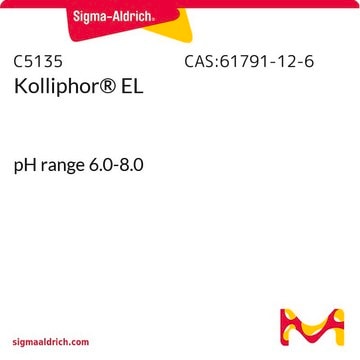K0250
Kainic acid monohydrate
≥99% (TLC), powder, ionotropic glutamate receptor (kainate class) agonist
Sinonimo/i:
Digenin, Kainate, 2-Carboxy-3-carboxymethyl-4-isopropenylpyrrolidine
Scegli un formato
Scegli un formato
About This Item
Prodotti consigliati
Nome del prodotto
Kainic acid monohydrate, ≥99% (TLC)
Saggio
≥99% (TLC)
Stato
powder
Impurezze
Glutamate, free
Solubilità
H2O: soluble
Temperatura di conservazione
2-8°C
Stringa SMILE
O.CC(=C)[C@H]1CN[C@@H]([C@H]1CC(O)=O)C(O)=O
InChI
1S/C10H15NO4.H2O/c1-5(2)7-4-11-9(10(14)15)6(7)3-8(12)13;/h6-7,9,11H,1,3-4H2,2H3,(H,12,13)(H,14,15);1H2/t6-,7+,9-;/m0./s1
FZNZRJRSYLQHLT-SLGZUKMRSA-N
Informazioni sul gene
human ... GRIA1(2890) , GRIA2(2891) , GRIA4(2893) , GRIK1(2897) , GRIK2(2898) , GRIK3(2899) , GRIK4(2900) , GRIK5(2901) , SLC1A1(6505) , SLC1A2(6506) , SLC1A3(6507)
mouse ... Gria1(14799)
rat ... Gria1(50592) , Grik1(29559) , Grik4(24406) , Grin2a(24409)
Cerchi prodotti simili? Visita Guida al confronto tra prodotti
Descrizione generale
Applicazioni
Azioni biochim/fisiol
Caratteristiche e vantaggi
Nota sulla preparazione
Prodotti correlati
Codice della classe di stoccaggio
11 - Combustible Solids
Classe di pericolosità dell'acqua (WGK)
WGK 3
Punto d’infiammabilità (°F)
Not applicable
Punto d’infiammabilità (°C)
Not applicable
Dispositivi di protezione individuale
Eyeshields, Gloves, type N95 (US)
Scegli una delle versioni più recenti:
Possiedi già questo prodotto?
I documenti relativi ai prodotti acquistati recentemente sono disponibili nell’Archivio dei documenti.
I clienti hanno visto anche
Articoli
DISCOVER Bioactive Small Molecules for Neuroscience
Active Filters
Il team dei nostri ricercatori vanta grande esperienza in tutte le aree della ricerca quali Life Science, scienza dei materiali, sintesi chimica, cromatografia, discipline analitiche, ecc..
Contatta l'Assistenza Tecnica.















